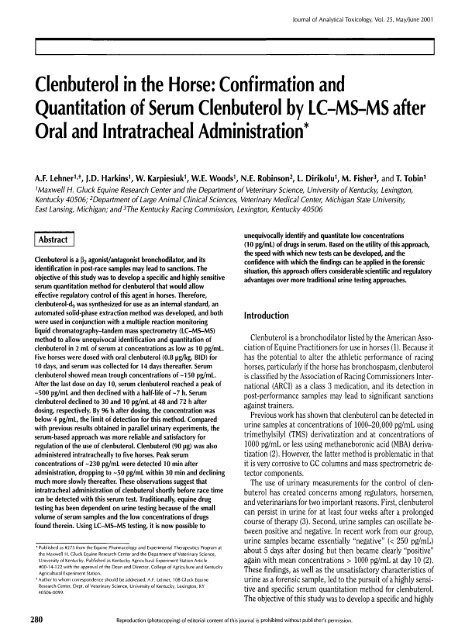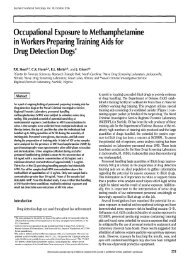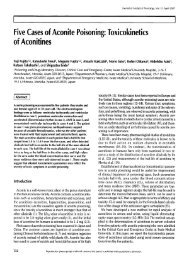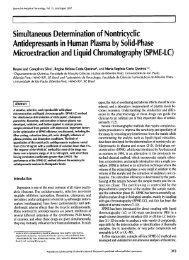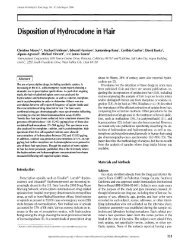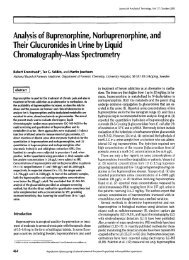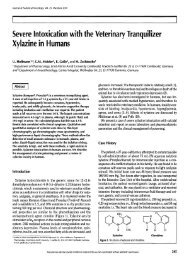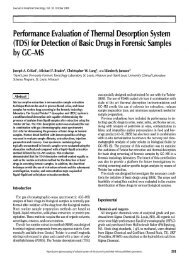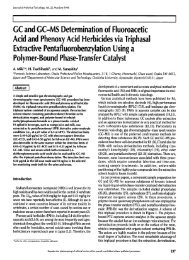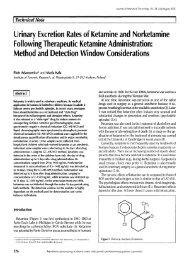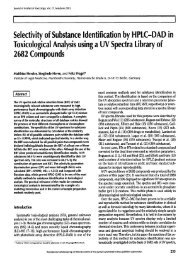Clenbuterol in the Horse: Confirmation and Quantitation of Serum ...
Clenbuterol in the Horse: Confirmation and Quantitation of Serum ...
Clenbuterol in the Horse: Confirmation and Quantitation of Serum ...
You also want an ePaper? Increase the reach of your titles
YUMPU automatically turns print PDFs into web optimized ePapers that Google loves.
Journal <strong>of</strong> Analytical Toxicology, Vol. 25, May/June 2001<br />
<strong>Clenbuterol</strong> <strong>in</strong> <strong>the</strong> <strong>Horse</strong>: <strong>Confirmation</strong> <strong>and</strong><br />
<strong>Quantitation</strong> <strong>of</strong> <strong>Serum</strong> <strong>Clenbuterol</strong> by LC-MS-MS after<br />
Oral <strong>and</strong> Intratracheal Adm<strong>in</strong>istration*<br />
A.F. Lehner 1,t, J.D. Hark<strong>in</strong>s 1, W. Karpiesiuk 1, W.E. Woods 1, N.E. Rob<strong>in</strong>son 2, L. Dirikolu 1, M. Fisher 3, <strong>and</strong> T. Tob<strong>in</strong> 1<br />
1Maxwell H. Gluck Equ<strong>in</strong>e Research Center <strong>and</strong> <strong>the</strong> Department <strong>of</strong> Veter<strong>in</strong>ary Science, University <strong>of</strong> Kentucky, Lex<strong>in</strong>gton,<br />
Kentucky 40506; 2Department <strong>of</strong> Large Animal Cl<strong>in</strong>ical Sciences, Veter<strong>in</strong>ary Medical Center, Michigan State University,<br />
East Lans<strong>in</strong>g, Michigan; <strong>and</strong> 3The Kentucky Rac<strong>in</strong>g Commission, Lex<strong>in</strong>gton, Kentucky 40506<br />
Abstract<br />
<strong>Clenbuterol</strong> is a ~2 agonist/antagonist bronchodilator, <strong>and</strong> its<br />
identification <strong>in</strong> post-race samples may lead to sanctions. The<br />
objective <strong>of</strong> this study was to develop a specific <strong>and</strong> highly sensitive<br />
serum quantitation method for clenbuterol that would allow<br />
effective regulatory control <strong>of</strong> this agent <strong>in</strong> horses. Therefore,<br />
clenbuterol-d 9 was syn<strong>the</strong>sized for use as an <strong>in</strong>ternal st<strong>and</strong>ard, an<br />
automated solid-phase extraction method was developed, <strong>and</strong> both<br />
were used <strong>in</strong> conjunction with a multiple reaction monitor<strong>in</strong>g<br />
liquid chromatography-t<strong>and</strong>em mass spectrometry (LC-MS-MS)<br />
method to allow unequivocal identification <strong>and</strong> quantitation <strong>of</strong><br />
clenbuterol <strong>in</strong> 2 mL <strong>of</strong> serum at concentrations as low as 10 pg/mL.<br />
Five horses were dosed with oral clenbutero[ (0.8 pg/kg, BID) for<br />
10 days, <strong>and</strong> serum was collected for 14 days <strong>the</strong>reafter. <strong>Serum</strong><br />
clenbuterol showed mean trough concentrations <strong>of</strong> ~150 pg/mL.<br />
After <strong>the</strong> last dose on day 10, serum clenbuterol reached a peak <strong>of</strong><br />
~500 pg/mL <strong>and</strong> <strong>the</strong>n decl<strong>in</strong>ed with a half-life <strong>of</strong> ~7 h. <strong>Serum</strong><br />
clenbuterol decl<strong>in</strong>ed to 30 <strong>and</strong> 10 pg/mL at 48 <strong>and</strong> 72 h after<br />
dos<strong>in</strong>g, respectively. By 96 h after dos<strong>in</strong>g, <strong>the</strong> concentration was<br />
below 4 pg/mL, <strong>the</strong> limit <strong>of</strong> detection for this method. Compared<br />
with previous results obta<strong>in</strong>ed <strong>in</strong> parallel ur<strong>in</strong>ary experiments, <strong>the</strong><br />
serum-based approach was more reliable <strong>and</strong> satisfactory for<br />
regulation <strong>of</strong> <strong>the</strong> use <strong>of</strong> clenbuterol. <strong>Clenbuterol</strong> (90 pg) was also<br />
adm<strong>in</strong>istered <strong>in</strong>tratracheally to five horses. Peak serum<br />
concentrations <strong>of</strong> ~230 pg/ml were detected 10 ra<strong>in</strong> after<br />
adm<strong>in</strong>istration, dropp<strong>in</strong>g to ~50 pg/mL with<strong>in</strong> 30 ra<strong>in</strong> <strong>and</strong> decl<strong>in</strong><strong>in</strong>g<br />
much more slowly <strong>the</strong>reafter. These observations suggest that<br />
<strong>in</strong>tratracheal adm<strong>in</strong>istration <strong>of</strong> clenbuterol shortly before race time<br />
can be detected with this serum test. Traditionally, equ<strong>in</strong>e drug<br />
test<strong>in</strong>g has been dependent on ur<strong>in</strong>e test<strong>in</strong>g because <strong>of</strong> <strong>the</strong> small<br />
volume <strong>of</strong> serum samples <strong>and</strong> <strong>the</strong> low concentrations <strong>of</strong> drugs<br />
found <strong>the</strong>re<strong>in</strong>. Us<strong>in</strong>g LC-MS-MS test<strong>in</strong>g, it is now possible to<br />
* Published as #275 from <strong>the</strong> Equ<strong>in</strong>e Pharmacology <strong>and</strong> Experimental Therapeutics Program at<br />
<strong>the</strong> Maxwell H. Gluck Equ<strong>in</strong>e Research Center <strong>and</strong> <strong>the</strong> Department <strong>of</strong> Veter<strong>in</strong>ary Science,<br />
University <strong>of</strong> Kentucky. Published as Kentucky Agricultural Experiment Station Article<br />
#00-14-122 with <strong>the</strong> approval <strong>of</strong> <strong>the</strong> Dean <strong>and</strong> Director, College <strong>of</strong> Agricuhure <strong>and</strong> Kentucky<br />
Agricultural Experiment Station.<br />
" Author to whom correspondence should be addressed. A.F. Lehner, 108 Gluck Equ<strong>in</strong>e<br />
Research Center, Dept. <strong>of</strong> Veter<strong>in</strong>ary Science, University <strong>of</strong> Kentucky, Lex<strong>in</strong>gton, KY<br />
40506-0099.<br />
unequivocally identify <strong>and</strong> quantitate low concentrations<br />
(10 pg/mL) <strong>of</strong> drugs <strong>in</strong> serum. Based on <strong>the</strong> utility <strong>of</strong> this approach,<br />
<strong>the</strong> speed with which new tests can be developed, <strong>and</strong> <strong>the</strong><br />
confidence with which <strong>the</strong> f<strong>in</strong>d<strong>in</strong>gs can be applied <strong>in</strong> <strong>the</strong> forensic<br />
situation, this approach <strong>of</strong>fers considerable scientific <strong>and</strong> regulatory<br />
advantages over more traditional ur<strong>in</strong>e test<strong>in</strong>g approaches.<br />
Introduction<br />
<strong>Clenbuterol</strong> is a bronchodilator listed by <strong>the</strong> American Asso-<br />
ciation <strong>of</strong> Equ<strong>in</strong>e Practitioners for use <strong>in</strong> horses (1). Because it<br />
has <strong>the</strong> potential to alter <strong>the</strong> athletic performance <strong>of</strong> rac<strong>in</strong>g<br />
horses, particularly if <strong>the</strong> horse has bronchospasm, clenbuterol<br />
is classified by <strong>the</strong> Association <strong>of</strong> Rac<strong>in</strong>g Commissioners Inter-<br />
national (ARCI) as a class 3 medication, <strong>and</strong> its detection <strong>in</strong><br />
post-performance samples may lead to significant sanctions<br />
aga<strong>in</strong>st tra<strong>in</strong>ers.<br />
Previous work has shown that clenbuterol can be detected <strong>in</strong><br />
ur<strong>in</strong>e samples at concentrations <strong>of</strong> 1000-20,000 pg/mL us<strong>in</strong>g<br />
trimethylsilyl (TMS) derivatization <strong>and</strong> at concentrations <strong>of</strong><br />
1000 pg/mL or less us<strong>in</strong>g methaneboronic acid (MBA) deriva-<br />
tization (2). However, <strong>the</strong> latter method is problematic <strong>in</strong> that<br />
it is very corrosive to GC columns <strong>and</strong> mass spectrometric de-<br />
tector components.<br />
The use <strong>of</strong> ur<strong>in</strong>ary measurements for <strong>the</strong> control <strong>of</strong> clen-<br />
buterol has created concerns among regulators, horsemen,<br />
<strong>and</strong> veter<strong>in</strong>arians for two important reasons. First, clenbuterol<br />
can persist <strong>in</strong> ur<strong>in</strong>e for at least four weeks after a prolonged<br />
course <strong>of</strong> <strong>the</strong>rapy (3). Second, ur<strong>in</strong>e samples can oscillate be-<br />
tween positive <strong>and</strong> negative. In recent work from our group,<br />
ur<strong>in</strong>e samples became essentially "negative" (< 250 pg/mL)<br />
about 5 days after dos<strong>in</strong>g but <strong>the</strong>n became clearly "positive"<br />
aga<strong>in</strong> with mean concentrations > 1000 pg/mL at day 10 (2).<br />
These f<strong>in</strong>d<strong>in</strong>gs, as well as <strong>the</strong> unsatisfactory characteristics <strong>of</strong><br />
ur<strong>in</strong>e as a forensic sample, led to <strong>the</strong> pursuit <strong>of</strong> a highly sensi-<br />
tive <strong>and</strong> specific serum quantitation method for clenbuterol.<br />
The objective <strong>of</strong> this study was to develop a specific <strong>and</strong> highly<br />
280 Reproduction (photocopy<strong>in</strong>g) <strong>of</strong> editorial content <strong>of</strong> this journal is prohibited without publisher's permission.
Journal <strong>of</strong> Analytical Toxicology, Vol. 25, May/June 2001<br />
sensitive serum quantitation method for clenbuterol that would<br />
allow for effective regulatory control <strong>of</strong> this agent <strong>in</strong> horses.<br />
Materials <strong>and</strong> Methods<br />
<strong>Horse</strong>s<br />
Five mature Thoroughbred mares weigh<strong>in</strong>g 489-535 kg were<br />
used for this experiment. The animals were ma<strong>in</strong>ta<strong>in</strong>ed on<br />
grass hay <strong>and</strong> feed (12% prote<strong>in</strong>), which was a 50:50 mixture <strong>of</strong><br />
oats <strong>and</strong> an alfalfa-based prote<strong>in</strong> pellet. <strong>Horse</strong>s were fed twice a<br />
day. The animals were vacc<strong>in</strong>ated annually for tetanus <strong>and</strong><br />
were dewormed quarterly with ivermect<strong>in</strong> (MSD Agvet, Rahway,<br />
N J). A rout<strong>in</strong>e cl<strong>in</strong>ical exam<strong>in</strong>ation was performed before each<br />
experiment to assure that <strong>the</strong> animals were healthy <strong>and</strong> sound.<br />
<strong>Horse</strong>s were kept <strong>in</strong> a 20-acre field until <strong>the</strong>y were placed <strong>in</strong> box<br />
stalls where <strong>the</strong>y were provided water <strong>and</strong> hay ad libitum. Animals<br />
used <strong>in</strong> <strong>the</strong>se experiments were managed accord<strong>in</strong>g to <strong>the</strong><br />
rules <strong>and</strong> regulations <strong>of</strong> <strong>the</strong> University <strong>of</strong> Kentucky's Institutional<br />
Animal Care Use Committee, which also approved <strong>the</strong> experimental<br />
protocol.<br />
<strong>Clenbuterol</strong> (Ventipulm<strong>in</strong> syrup, Boehr<strong>in</strong>ger Ingelheim<br />
Vetmedica, Inc, St. Joseph, MO) was adm<strong>in</strong>istered orally at a<br />
dosage <strong>of</strong> 0.8 pg/kg at 8 a.m. <strong>and</strong> 5 p.m. for 10.5 days (21 dos<strong>in</strong>gs).<br />
Us<strong>in</strong>g Vacuta<strong>in</strong>er | tubes (SST Gel <strong>and</strong> Clot Activator,<br />
Becton Dick<strong>in</strong>son, Frankl<strong>in</strong> U/kes, N J), serum samples were<br />
collected before treatment started <strong>and</strong> <strong>the</strong>n each day before <strong>the</strong><br />
morn<strong>in</strong>g dos<strong>in</strong>g. Fur<strong>the</strong>rmore, after <strong>the</strong> 21st dos<strong>in</strong>g (<strong>the</strong><br />
morn<strong>in</strong>g <strong>of</strong> <strong>the</strong> 11th day), samples were collected at 1, 2, 4, 6,<br />
<strong>and</strong> 8 h after treatment. After that, samples were collected each<br />
morn<strong>in</strong>g for <strong>the</strong> next 14 days.<br />
In a second experiment, <strong>in</strong>jectable clenbuterol (Ventipulm<strong>in</strong>,<br />
Boehr<strong>in</strong>ger Ingelheim, Ltd., Burl<strong>in</strong>gton, Ontario, Canada) was<br />
adm<strong>in</strong>istered <strong>in</strong>tratracheally (90 pg) to five horses. <strong>Serum</strong> samples<br />
were collected before treatment <strong>and</strong> at 10, 20, <strong>and</strong> 30 m<strong>in</strong><br />
<strong>and</strong> 1, 2, 4, 8, <strong>and</strong> 24 h after treatment.<br />
Synihesis <strong>and</strong> characterization <strong>of</strong> deuterated clenbuterol-d9<br />
Figure 1 shows <strong>the</strong> syn<strong>the</strong>sis <strong>of</strong> clenbuterol-d9 (4-am<strong>in</strong>o-tx-<br />
[(tert-butyl-d9-am<strong>in</strong>o)methyl]-3,5-dichlorobenzyl alcohol). The<br />
tert-butylam<strong>in</strong>e-d9 (98 atom % D, m<strong>in</strong>imum quality) was from<br />
Isotec, Inc. (Miamisburg, OH). All o<strong>the</strong>r reagents <strong>and</strong> solvents<br />
NI-I 2 NH2<br />
4-Amtnoacetophenone<br />
CD 3<br />
O%,,~,,N,,~CDa<br />
/ H CD3<br />
D, ~ ' ~ N~BH4. CH-~O H m<br />
Cl ~ ~ "CI<br />
Nil 2<br />
O<br />
Br~, CHC~ I~N~Bu-r THF<br />
I, ==<br />
CI CI<br />
NH 2<br />
4-Ami no-m-br omo-3,5-dlchlo ro-<br />
acetophenone<br />
Z<br />
CD 3<br />
HO- A ,,,~OO 3<br />
CI ~ ~ -CI<br />
NH z<br />
<strong>Clenbuterol</strong>-.d=<br />
Figure 1. Scheme for <strong>the</strong> syn<strong>the</strong>sis <strong>of</strong> clenbuterol-d 9.<br />
N oo,<br />
were from Aldrich (Milwaukee, WI) <strong>and</strong> were analytical grade or<br />
better. The substrate for this syn<strong>the</strong>sis was 4-am<strong>in</strong>o-acetophe-<br />
none. Chlor<strong>in</strong>ation <strong>of</strong> 4-am<strong>in</strong>o-acetophenone <strong>in</strong> acetic acid<br />
gave <strong>the</strong> 3,5-dichloro derivative, which after brom<strong>in</strong>ation <strong>in</strong><br />
chlor<strong>of</strong>orm provided 4-am<strong>in</strong>o-co-bromo-3,5-dichloro-ace-<br />
tophenone (4). The reaction <strong>of</strong> <strong>the</strong> bromoketone with deuter-<br />
ated tert-butylam<strong>in</strong>e (H2NtBu-d9) <strong>in</strong> tetrahydr<strong>of</strong>uran gave <strong>the</strong><br />
ketoam<strong>in</strong>e <strong>in</strong> moderate yield, which, after reduction to alcohol<br />
with sodium borohydride <strong>in</strong> methanol, yielded clenbuterol-d9.<br />
The f<strong>in</strong>al product was purified by column chromatography on<br />
silica gel <strong>and</strong> crystallized from ethyl e<strong>the</strong>r.<br />
Characterization data for 4-am<strong>in</strong>o-o~-[(tert-butyl-dg-<br />
am<strong>in</strong>o)methyl]-3,5-dichlorobenzyl alcohol: colorless crystals<br />
from ethyl e<strong>the</strong>r, melt<strong>in</strong>g po<strong>in</strong>t 182-185~ 1H-NMR (300 MHz,<br />
CDC13): d (ppm) 2.91 (dd, 1 H,J 10.5 Hz, J 12.0 Hz), 3.18 (dd,<br />
1H, J2.4 Hz, J 12.0 Hz), 4.48 (s, 2H), 5.30 (dd, 1H, J2.4 Hz, J<br />
10.5 Hz), 7.29 (s, 2H).<br />
Validation <strong>of</strong> quantitative liquid chromatography-<br />
t<strong>and</strong>em mass spectrometry (IC-MS-MS) method for<br />
serum clenbuterol<br />
The LC-MS-MS method for <strong>the</strong> quantitation <strong>of</strong> clenbuterol<br />
was validated by exam<strong>in</strong><strong>in</strong>g <strong>the</strong> measurement <strong>of</strong> consistency <strong>of</strong><br />
results (with<strong>in</strong> run <strong>and</strong> between run), correlation (coefficient <strong>of</strong><br />
determ<strong>in</strong>ation <strong>of</strong> <strong>the</strong> st<strong>and</strong>ard curve), <strong>and</strong> recovery <strong>of</strong> <strong>the</strong> assay.<br />
The with<strong>in</strong>-run precision was calculated from similar responses<br />
from six repeats <strong>of</strong> <strong>the</strong>se three st<strong>and</strong>ards <strong>in</strong> one run. The be-<br />
tween-run precision was determ<strong>in</strong>ed by compar<strong>in</strong>g <strong>the</strong> calcu-<br />
lated response (<strong>in</strong> picograms per milliliter backfit <strong>of</strong> <strong>the</strong><br />
st<strong>and</strong>ard curve) <strong>of</strong> <strong>the</strong> low (10 pg/mL), middle (100 pg/mL), <strong>and</strong><br />
high (1000 pg/mL) st<strong>and</strong>ards over six consecutive daily runs.<br />
St<strong>and</strong>ard curve correlation was measured by <strong>the</strong> mean coeffi-<br />
cient <strong>of</strong> determ<strong>in</strong>ation (r 2) for six consecutive daily runs (5).<br />
The recovery was determ<strong>in</strong>ed by compar<strong>in</strong>g <strong>the</strong> response (<strong>in</strong><br />
area) <strong>of</strong> low (50 pg/mL), high (500 pg/mL), <strong>and</strong> <strong>the</strong> deuterated<br />
ctenbuterol (25,000 pg/mL) methanol st<strong>and</strong>ards to <strong>the</strong> equiva-<br />
lent extracted st<strong>and</strong>ards. The limit <strong>of</strong> detection (LOD) was cal-<br />
culated as <strong>the</strong> mean <strong>of</strong> <strong>the</strong> assay background plus two times <strong>the</strong><br />
st<strong>and</strong>ard deviation <strong>of</strong> <strong>the</strong> mean for 122 runs. The limit <strong>of</strong> quan-<br />
titation (LOQ) was likewise calculated as five times <strong>the</strong> st<strong>and</strong>ard<br />
deviation <strong>of</strong> <strong>the</strong> mean (6).<br />
Development <strong>of</strong> a LC-MS-MS method for clenbuterol<br />
<strong>Clenbuterol</strong> <strong>and</strong> clenbuterol-d9 were dissolved at 10 pg/mL <strong>in</strong><br />
1:1 acetonitrile/0.05% formic acid <strong>and</strong> exam<strong>in</strong>ed by direct <strong>in</strong>-<br />
fusion ESI + MS. Mass spectra derived follow<strong>in</strong>g optimization <strong>of</strong><br />
tun<strong>in</strong>g revealed <strong>in</strong>tense [M+H] + molecular ions with little post-<br />
source fragmentation (Figure 2), <strong>in</strong>dicat<strong>in</strong>g <strong>the</strong> appropriateness<br />
<strong>of</strong> this approach for development <strong>of</strong> a sensitive quantitative<br />
procedure. Negative ion ESI was not <strong>in</strong>vestigated because <strong>of</strong> <strong>the</strong><br />
lack <strong>of</strong> negatively ionizable functionalities. High-performance<br />
liquid chromatography (HPLC) <strong>of</strong> clenbuterol <strong>in</strong> acidified or-<br />
ganic/aqueous mobile phases revealed <strong>the</strong> propensity for ex-<br />
cellent chromatography with little tail<strong>in</strong>g <strong>and</strong> no need for<br />
post-column flow splitt<strong>in</strong>g or acidification by <strong>in</strong>fusion <strong>of</strong> acid.<br />
O<strong>the</strong>r c<strong>and</strong>idate compounds <strong>of</strong> related structure (salbutamol,<br />
isoproterenol, terbutal<strong>in</strong>e, ephedr<strong>in</strong>e) were <strong>in</strong>vestigated as po-<br />
tential <strong>in</strong>ternal st<strong>and</strong>ards before <strong>the</strong> development <strong>of</strong> <strong>the</strong> d9<br />
281
compound <strong>and</strong> generally found to provide relatively broad<br />
peaks, with <strong>the</strong> exception <strong>of</strong> ephedr<strong>in</strong>e, which was considered<br />
suitable both dur<strong>in</strong>g HPLC <strong>and</strong> dur<strong>in</strong>g extraction, but which<br />
did not enable as low an LOQ or <strong>the</strong> high correlation coeffi-<br />
cients achieved with clenbuterol-d9. The extraction method<br />
was based on exist<strong>in</strong>g SPE methods developed for o<strong>the</strong>r basic<br />
drugs <strong>and</strong> found to provide adequate recovery.<br />
<strong>Serum</strong> analysis for clenbuterol by LC-MS-MS<br />
St<strong>and</strong>ard solutions <strong>of</strong> clenbuterol <strong>and</strong> clenbuterol-d9 were<br />
prepared <strong>in</strong> methanol. Extraction st<strong>and</strong>ards were prepared by<br />
<strong>the</strong> addition <strong>of</strong> a known amount <strong>of</strong> a clenbuterol solution to<br />
blank serum samples at a range <strong>of</strong> 10-1000 pg/mL. A known<br />
amount <strong>of</strong> a clenbuterol-d9 st<strong>and</strong>ard (50 IJg <strong>of</strong> 1 IJg/mL <strong>in</strong> 10%<br />
mobile phase <strong>in</strong> H20) was added to each sample, st<strong>and</strong>ard, <strong>and</strong><br />
blank as an <strong>in</strong>ternal st<strong>and</strong>ard.<br />
The serum samples, st<strong>and</strong>ards, <strong>and</strong> blanks (2 mL/sample)<br />
were placed <strong>in</strong> culture tubes. Then 2 mL <strong>of</strong> 0.1M sodium phos-<br />
phate buffer (pH 6) was added, <strong>and</strong> <strong>the</strong> sample pH was adjusted<br />
as needed to 6.0 + 0.5 with 1M NaOH or 1M HCI. St<strong>and</strong>ards<br />
were prepared at <strong>the</strong> follow<strong>in</strong>g concentrations: 0.0, 10, 50, 100,<br />
500, <strong>and</strong> 1000 pg/mL from appropriate concentrated stocks <strong>in</strong><br />
mobile phase.<br />
Extraction procedure. Solid-phase extraction (SPE) was per-<br />
formed on <strong>the</strong> Rapid Trace | SPE Workstation (Zymark Corp.,<br />
Hopk<strong>in</strong>ton, MA). Clean Screen SPE columns (Worldwide Mon-<br />
itor<strong>in</strong>g #ZSDAU020) were conditioned by sequential addition <strong>of</strong><br />
3 mL <strong>of</strong> methanol, 3 mL <strong>of</strong> water, <strong>and</strong> 1 mL <strong>of</strong> 0.1M sodium<br />
phosphate buffer (pH 6). The samples were loaded at 1.5<br />
mL/m<strong>in</strong>, <strong>and</strong> <strong>the</strong> column was washed sequentially with 2 mL <strong>of</strong><br />
water, 2 mL <strong>of</strong> 1M acetic acid, <strong>and</strong> 4 mL <strong>of</strong> methanol. The SPE<br />
column was dried with N2 gas for 5 m<strong>in</strong> <strong>the</strong>n eluted with 3 mL<br />
<strong>of</strong> dichloromethane/isopropanol/NH4OH, conc. (78:20:2) at 1.5<br />
mL/m<strong>in</strong>. The eluent was evaporated to dryness under a stream<br />
<strong>of</strong> N2 (< 40~ Each sample was dissolved <strong>in</strong> 50 pL <strong>of</strong> Solvent<br />
A (see Instrumentation).<br />
Instrumentation. Extracts were analyzed with a Hewlett-<br />
Packard model 1050 LC equipped with a Micromass VG<br />
Quattro-II MS-MS (Micromass, Beverly, MA) set <strong>in</strong> electro-<br />
spray ionization-positive mode (ESI§ The column was a Luna<br />
phenyl/hexyl 2 mmx 250 mm x 5 IJm (Phenomenex, Torrence,<br />
CA). The mobile phase was a l<strong>in</strong>ear gradient <strong>of</strong> Solvent A (0.05%<br />
w/v formic acid <strong>in</strong> water + 5% v/v acetonitrile) <strong>and</strong> Solvent B<br />
282<br />
Table I. Sett<strong>in</strong>gs Used for <strong>Clenbuterol</strong> <strong>and</strong> <strong>Clenbuterol</strong>-d9<br />
Data Acquisition by ESI § LC-MS-MS<br />
Precursor Product Collision Cone<br />
ion (m/z) ion (m/z) Dwell (s) energy (eV) voltage (V)<br />
277 259 0.01 16 19<br />
277 203 0.05 16 19<br />
277 57 0.01 16 19<br />
279 205 0.01 16 19<br />
279 261 0.01 16 19<br />
279 57 0.01 16 19<br />
286 204 0.05 16 19<br />
288 206 0.01 16 19<br />
Journal <strong>of</strong> Analytical Toxicology, Vol. 25, May/June 2001<br />
(0.05% w/v formic acid <strong>in</strong> acetonitrile), flow<strong>in</strong>g at 0.45 mL/m<strong>in</strong><br />
throughout <strong>and</strong> which varied as follows: 0 m<strong>in</strong>, 100% A; 1 ra<strong>in</strong>,<br />
100% A; 5 m<strong>in</strong>, 10.5% A <strong>and</strong> 89.5% B; 10 ra<strong>in</strong>, 10.5% A <strong>and</strong><br />
89.5% B; 10.5 ra<strong>in</strong>, 100% A; 15 m<strong>in</strong>, 100% A. Each sample was<br />
transferred to an autosampler vial from which a 25-1JL aliquot<br />
was <strong>in</strong>jected onto <strong>the</strong> LC-MS-MS. Transitions monitored for<br />
clenbuterol <strong>and</strong> its deuterated <strong>in</strong>ternal st<strong>and</strong>ard are summa-<br />
rized <strong>in</strong> Table I. <strong>Quantitation</strong> <strong>of</strong> clenbuterol was based on <strong>the</strong><br />
m/z 277 -~ 203 transition corrected by <strong>the</strong> <strong>in</strong>ternal st<strong>and</strong>ard<br />
(clenbuterol-dg) m/z 286 -~ 204 transition.<br />
MS-MS<br />
Full scan ESI § mass spectra were obta<strong>in</strong>ed on clenbuterol<br />
(Sigma, St. Louis, MO) <strong>and</strong> its <strong>in</strong>ternal st<strong>and</strong>ard at 10 IJg/mL <strong>in</strong><br />
1:1 acetonitrile/0.05% formic acid (aq), pH 3, by <strong>in</strong>fusion at 0.6<br />
mL/h with a Harvard syr<strong>in</strong>ge pump (Holliston, MA). The<br />
Quattro II MS was tuned for positive mode by direct <strong>in</strong>fusion <strong>of</strong><br />
10,000 pg/IJL <strong>of</strong> clenbuterol <strong>in</strong> 1:1 acetonitrile/0.05% formic<br />
acid (aq). The peak shape <strong>and</strong> <strong>in</strong>tensity <strong>of</strong> <strong>the</strong> monoprotonated<br />
clenbuteroi m/z 277 ion were optimized by adjustment <strong>of</strong> cap-<br />
illary, HV lens, cone voltage, skimmer lens, <strong>and</strong> RF lens set-<br />
t<strong>in</strong>gs. Collision gas (argon) <strong>and</strong> collision energy were adjusted<br />
for collision-<strong>in</strong>duced dissociation (CID) <strong>in</strong> <strong>the</strong> central hexapole<br />
by optimiz<strong>in</strong>g sett<strong>in</strong>gs for maximum production <strong>of</strong> <strong>the</strong> m/z<br />
203 product ion. Generally, <strong>the</strong> collision gas was set to I x 10 -3<br />
mbar, <strong>the</strong> source cone voltage was set at +19 V, <strong>the</strong> collision en-<br />
ergy was set at -16 V, <strong>the</strong> capillary <strong>of</strong> <strong>the</strong> ESI probe was set at<br />
+2.6 kvolts, skimmer was set at 1.0 V, <strong>and</strong> <strong>the</strong> HV lens was set<br />
at +0.5 kvolts. Source temperature was set at 120~<br />
<strong>Quantitation</strong> <strong>of</strong> serum clenbuterol us<strong>in</strong>g LC-MS-MS<br />
<strong>Clenbuterol</strong> st<strong>and</strong>ard curves were generated by automated<br />
data collection (Micromass MassLynx s<strong>of</strong>tware, Beverly, MA)<br />
<strong>and</strong> fitt<strong>in</strong>g <strong>of</strong> resultant data to a second-order quadratic curve<br />
generated with Micros<strong>of</strong>t Excel s<strong>of</strong>tware (www.micros<strong>of</strong>t.com).<br />
Sigma Plot (SPSS, Inc) enabled convenient plott<strong>in</strong>g <strong>of</strong> st<strong>and</strong>ard<br />
curves where necessary. Typical results showed a range <strong>of</strong> MS<br />
response areas from approximately 400 (background) for 0<br />
pg/mL to 20,000 for 1000 pg/mL with excellent po<strong>in</strong>t fit to <strong>the</strong><br />
curve.<br />
Results<br />
Purity <strong>and</strong> mass spectral characteristics <strong>of</strong> clenbuterol-d9<br />
The ESI § MS full scan <strong>of</strong> clenbuterol-d9 is shown <strong>in</strong> Figure 2.<br />
Intensities <strong>of</strong> peaks immediately preced<strong>in</strong>g m/z 286 suggested<br />
that <strong>the</strong>re were small amounts <strong>of</strong> ds <strong>and</strong> d7 <strong>in</strong> this preparation,<br />
roughly 7% <strong>and</strong> 2%, respectively. This is emphasized by com-<br />
parison to undeuterated clenbuterol (Figure 3), <strong>in</strong> which no<br />
peaks were present immediately preced<strong>in</strong>g <strong>the</strong> major molecular<br />
ion at m/z 277. Of more immediate concern was whe<strong>the</strong>r this<br />
preparation conta<strong>in</strong>ed undeuterated clenbuterol-do, which<br />
would arise from undeuterated contam<strong>in</strong>ants <strong>in</strong> <strong>the</strong> tert-buty-<br />
lam<strong>in</strong>e-d9 dur<strong>in</strong>g <strong>the</strong> orig<strong>in</strong>al reaction. Direct <strong>in</strong>fusion <strong>and</strong><br />
HPLC measurements estimated <strong>the</strong> amount <strong>of</strong> clenbuterol-d0<br />
at no more than 0.01%, lend<strong>in</strong>g assurance that even relatively
Journal <strong>of</strong> Analytical Toxicology, Vol. 25, May/June 2001<br />
large amounts <strong>of</strong> this <strong>in</strong>ternal st<strong>and</strong>ard could be added without<br />
creat<strong>in</strong>g problems for <strong>the</strong> accurate quantitation <strong>of</strong> clenbuterol.<br />
Validation <strong>of</strong> quantitative LC-MS-MS method for serum<br />
clenbuterol<br />
The with<strong>in</strong>-run precision was determ<strong>in</strong>ed for <strong>the</strong> low (10<br />
pg/mL: CV = 17.9%), middle (100 pg/mL: CV = 3.7%), <strong>and</strong> high<br />
(1000 pg/mL: CV = 0.7%) concentrations <strong>of</strong> <strong>the</strong> clenbuterol<br />
st<strong>and</strong>ard curve, with a mean CV <strong>of</strong> 7.4%. The between-run pre-<br />
cision was determ<strong>in</strong>ed for <strong>the</strong> low (10 pg/mL: CV = 29.3%),<br />
middle (100 pg/mL: CV = 7.2%), <strong>and</strong> high (1000 pg/mL: CV =<br />
0.1%) concentrations <strong>of</strong> <strong>the</strong> clenbuterol st<strong>and</strong>ard curve, with a<br />
mean CV <strong>of</strong> 12.2%. The mean r 2 for <strong>the</strong> assays were 0.99989 +<br />
0.00006 SD. The recovery was determ<strong>in</strong>ed at two concentra-<br />
tions: low (50 pg/mL) = 86.5%, high (500 pg/mL) = 76.8; <strong>the</strong> re-<br />
covery for <strong>the</strong> deuterated clenbuterol was 65.1%. The LOD for<br />
<strong>the</strong> LC-MS-MS method for <strong>the</strong> detection <strong>of</strong> clenbuterol was 4<br />
pg/mL (n = 12), <strong>and</strong> <strong>the</strong> LOQ was 13 pg/mL (n = 12).<br />
'1 T<br />
o,~ D<br />
~ A ,r ./~'k./P<br />
170 180 1gO 200 210 220 230 240 250 280 270 280 2~ 300<br />
m/z<br />
Figure 2. Full scan ESI+ MS <strong>of</strong> clenbuterol-d9 obta<strong>in</strong>ed by direct <strong>in</strong>fusion<br />
<strong>of</strong> a 10-pg/mL solution <strong>in</strong> acetonitrile/0.05% formic acid (aq) (1:1). Inset<br />
displays structure <strong>in</strong>clud<strong>in</strong>g location <strong>of</strong> deteriums.<br />
II A<br />
88<br />
284285 2/~7 9R9290<br />
mlz<br />
. . . . . . . . . . . . . . . . . .<br />
" |278 f i<br />
I,~/ I~o#81<br />
272274276278280282284286288290202294296<br />
m/z<br />
Figure 3. Full scan ESI + MS <strong>of</strong> clenbuterol-d9 (A) <strong>and</strong> clenbuterol-d0 (B)<br />
with emphasis placed on <strong>the</strong> spectral w<strong>in</strong>dow immediately adjacent to<br />
<strong>the</strong> respective compounds' molecular ion group. Spectra were obta<strong>in</strong>ed<br />
by direct <strong>in</strong>fusion <strong>of</strong> a 10-pg/mL solution <strong>in</strong> acetonitrile/0.05% formic<br />
acid (aq)(1:1).<br />
Multiple reaction monitor<strong>in</strong>g <strong>of</strong> clenbuterol<br />
Figure 4 shows product ions for <strong>the</strong> two major [M+H] §<br />
molecular ions <strong>of</strong> clenbuterol, at m/z 277 <strong>and</strong> 279. <strong>Clenbuterol</strong><br />
quantitative measurements were enhanced by maximization <strong>of</strong><br />
<strong>the</strong> yield <strong>of</strong> product ions, specifically by optimization <strong>of</strong> collision<br />
gas pressure <strong>and</strong> tun<strong>in</strong>g parameters which resulted <strong>in</strong> signifi-<br />
cant yield <strong>of</strong> <strong>the</strong> m/z 203 ion from 277. Optimum yield for <strong>the</strong><br />
m/z 203 ion occurred with argon gas pressure at roughly 1 x<br />
10 -3 mbar (data not shown).<br />
Pr<strong>in</strong>cipal product ions aris<strong>in</strong>g from clenbuterol <strong>and</strong> <strong>the</strong> <strong>in</strong>-<br />
ternal st<strong>and</strong>ard clenbuterol-d9 [M+H] + molecular ions were si-<br />
multaneously optimized by focus<strong>in</strong>g on <strong>the</strong> m/z 277 -~ 203<br />
transition <strong>of</strong> clenbuteml. Table II lists <strong>the</strong> pr<strong>in</strong>cipal product ions<br />
observed dur<strong>in</strong>g direct <strong>in</strong>fusion-MS-MS experiments both for<br />
<strong>the</strong> [M+H] + molecular ions <strong>and</strong> <strong>the</strong> major water loss peaks<br />
aris<strong>in</strong>g from <strong>the</strong> largest molecular ion <strong>of</strong> each compound.<br />
Figure 5 depicts <strong>the</strong> fragmentation mechanism proposed for<br />
<strong>the</strong> m/z 277 - 203 transition <strong>of</strong> clenbuterol. Protonation is sug-<br />
gested to occur at <strong>the</strong> much more basic t-butylam<strong>in</strong>o nitrogen:<br />
compare model compounds t-butylam<strong>in</strong>e [PKa = 10.8] <strong>and</strong> 2,4-<br />
dichloroanil<strong>in</strong>e [PKa = 2.05] (7). Dehydration accounts for <strong>the</strong><br />
m/z 259 product ion, which <strong>the</strong>n undergoes McLafferty rear-<br />
rangement (8) <strong>in</strong>volv<strong>in</strong>g shift <strong>of</strong> a tert-butyl proton <strong>and</strong> dis-<br />
mlz<br />
A<br />
I! "~<br />
B<br />
I., .<br />
40 mCI ~ 70 QO ~0 1C01101201301401mOI~OI"~ISOIgO2CO21022D2~0240~21027021~<br />
m/z<br />
Figure 4. ESI § MS-MS daughter ion spectra <strong>of</strong> clenbuterol molecular ions<br />
m/z 277 (A) <strong>and</strong> m/z 279 (B). Spectra were obta<strong>in</strong>ed by direction <strong>in</strong>fu-<br />
sion <strong>of</strong>a 10-pg/mL solution <strong>in</strong> acetonitrile/0.05% formic acid (aq)(1:1).<br />
Note that <strong>the</strong> mass-to-charge ratio region from roughly 40 to 185 has<br />
been exp<strong>and</strong>ed for clarity <strong>of</strong> detail.<br />
Table II. Pr<strong>in</strong>cipal Product Ions Observed from<br />
<strong>Clenbuterol</strong> Molecular Ions (m/z 277, 279, <strong>and</strong> 281) <strong>and</strong><br />
Pr<strong>in</strong>cipal Water Loss Ion (m/z 259) dur<strong>in</strong>g ESI + MS-MS*<br />
<strong>Clenbuterol</strong> <strong>Clenbuterol</strong>-d 9<br />
Precursor Pr<strong>in</strong>cipal product Precursor Pr<strong>in</strong>cipal product<br />
ion (m/z) ion(s) (m/z) ion (m/z) ion(s) (m/z)<br />
277 259,203,57 286 268,204,66<br />
279 261,205,57 288 270,206,66<br />
281 263,207,57 290 272,208,66<br />
259 203,57 268 204,66<br />
* Right side <strong>of</strong> table enables comparison with pr<strong>in</strong>cipal product ions observed from<br />
<strong>the</strong> equivalent ions <strong>of</strong> <strong>the</strong> <strong>in</strong>ternal st<strong>and</strong>ard clenbuterol-dg.<br />
283
charge <strong>of</strong> a neutral 2-methylpropylene molecule. This reac-<br />
tion mechanism is supported by observations with clenbuterol-<br />
d9, whose rn/z 286 [M+H] § molecular ion elicits an m/z 268<br />
dehydration fragment with collapse to an m/z 204 ion, <strong>the</strong><br />
analogous fragment to <strong>the</strong> clenbuterol-d0 m/z 203 ion (Table I).<br />
The additional 1 amu <strong>of</strong> this fragment must arise specifically<br />
from transfer <strong>of</strong> a deuterium atom. O<strong>the</strong>r [M+H] § molecular<br />
ions <strong>in</strong> Table II (m/z 279 <strong>and</strong> 281 for clenbuterol <strong>and</strong> m/z 288<br />
<strong>and</strong> 290 for clenbuterol-d9) follow suit, respectively add<strong>in</strong>g two<br />
or four amu units to product ions depend<strong>in</strong>g upon <strong>the</strong> iso-<br />
topic contribution <strong>of</strong> chlor<strong>in</strong>e atoms. The m/z 57 (clenbuterol)<br />
<strong>and</strong> 66 (clenbuterol-dg) ions are uniform throughout as <strong>the</strong>y<br />
represent charged tert-butyl groups unaffected by chlor<strong>in</strong>e iso-<br />
topic contributions.<br />
Figure 6 demonstrates simultaneity <strong>of</strong> product ion transitions<br />
acquired for clenbuterol, <strong>in</strong>clud<strong>in</strong>g <strong>the</strong> 277 --, 203 quantitative<br />
transition <strong>and</strong> five qualifier transitions observed as nested sets<br />
dur<strong>in</strong>g gradient HPLC. It is our recommendation that clen-<br />
buterol confirmation <strong>in</strong>clude at least several <strong>of</strong> such qualifier<br />
transitions as diagnostic for accuracy <strong>in</strong> assignment <strong>of</strong> <strong>the</strong><br />
presence <strong>of</strong> clenbuterol, as is typically done accord<strong>in</strong>g to labo-<br />
284<br />
QH r<br />
h .;<br />
H H 3<br />
1-13<br />
b~'~H20 ,<br />
u + ~2H3 ,<br />
[===- ,~A ~CH3 --='=]<br />
Hd<br />
Protonated dehydration product<br />
m/z 259<br />
deuterated = m/z 268<br />
H21 ~ 2 ndzPrat~ 2'6"dichl~176176<br />
+<br />
deuterated = m/= 204<br />
H~H; Neutralfragrment<br />
C (2-methylpropylene)<br />
~H3* 56 =,=<br />
deuterat~d = 6,1a<strong>in</strong>u<br />
Pratonated clenbuterol<br />
* = deuterium atonm <strong>in</strong> clenbuterol-d9<br />
m/z 277<br />
deuterated = m/z 286<br />
Figure 5. Scheme show<strong>in</strong>g <strong>the</strong> fragmentation mechanism for <strong>the</strong> transi-<br />
tion from m/z 277 to 203 dur<strong>in</strong>g ESI + MS-MS <strong>of</strong> clenbuterol. Note that<br />
<strong>the</strong> asterisks denote <strong>the</strong> location <strong>of</strong> deuterium atoms <strong>in</strong> clenbuterol-d 9.<br />
I ,<br />
5.88<br />
Journal <strong>of</strong> Analytical Toxicology, Vol. 25, May/June 2001<br />
ratory st<strong>and</strong>ard operat<strong>in</strong>g procedures (SOP) dur<strong>in</strong>g selected<br />
ion monitor<strong>in</strong>g (SIM) mass spectrometry. The areas for <strong>the</strong><br />
specific product ions measured as <strong>in</strong> Figure 6 relative to <strong>the</strong><br />
largest transition were as follows: m/z 277 ~ 203, 100%; m/z<br />
279 --, 205, 64%; m/z 277 ~ 259, 14%; m/z 279 ~ 261, 7.3%;<br />
m/z 277 ~ 57, 1.4%; <strong>and</strong> m/z 279 ~ 57, 0.7%.<br />
100<br />
m/z 277--). 203<br />
m/z 279 --> 205<br />
m/z 277 --~ 259<br />
m/z 279 --~ 261<br />
m/z 277 --~ 67<br />
\ m/z 279 --> 57<br />
5.92 5.96 6.00 6.04 6.08 6.12 6.16 6.20 6.24<br />
Time (m<strong>in</strong>)<br />
Figure 6. Ion chromatography <strong>of</strong> clenbuterol product ion transitions. Gra-<br />
dient HPLC-MS-MS was carried out on a 1-ng/mL clenbuterol stan-<br />
dard, extracted, <strong>and</strong> chromatographed as described <strong>in</strong> Methods. Labels<br />
<strong>in</strong>dicate <strong>the</strong> respective nested transitions be<strong>in</strong>g monitored <strong>and</strong> acquired<br />
across <strong>the</strong> 6.06 m<strong>in</strong> peak.<br />
18000<br />
16000<br />
14000<br />
~ 12000<br />
10000<br />
C<br />
0<br />
Q.<br />
8000<br />
U~<br />
4000<br />
2000<br />
Ion = 277 to 203<br />
Coefficients:<br />
Y-<strong>in</strong>terccept = 332,8<br />
F I I ~ i<br />
0 200 400 600 800 1000<br />
<strong>Clenbuterol</strong> (pg/mL)<br />
Figure 7. A typical clenbuterol st<strong>and</strong>ard curve from serum. St<strong>and</strong>ards<br />
(n = 2) at five concentrations <strong>of</strong> clenbuterol were analyzed by<br />
LC-MS-MS. The po<strong>in</strong>ts are best fit by a quadratic equation.
Journal <strong>of</strong> Analytical Toxicology, Vol. 25, May/June 2001<br />
<strong>Quantitation</strong> <strong>of</strong> serum clenbuterol us<strong>in</strong>g LC-MS-MS<br />
Figure 7 shows a typical st<strong>and</strong>ard curve for clenbuterol <strong>in</strong><br />
serum us<strong>in</strong>g <strong>the</strong> LC-MS-MS methodology described. Dupli-<br />
cate st<strong>and</strong>ards at five concentrations (0.01, 0.05, 0.1, 0.5, 1.0<br />
ng/mL) <strong>of</strong> clenbuterol supplemented <strong>in</strong>to horse serum (plus<br />
blank, 0 ng/mL) were analyzed by LC-MS-MS. The st<strong>and</strong>ard<br />
curve is best described by a second-order quadratic regression,<br />
2)O<br />
i '~<br />
)O<br />
400.<br />
i=<br />
[<br />
0 84<br />
9 <strong>Clenbuterol</strong> (0.8 pg/kg; po, b.l.d x 10 days)<br />
n=8<br />
J<br />
0 '5 10 15<br />
Time (days)<br />
Figure 8. Trough serum concentrations dur<strong>in</strong>g <strong>and</strong> after clenbuterol<br />
treatment (0.8 pg/kg BID x 10 days). Open circles <strong>in</strong>dicate values that<br />
were below <strong>the</strong> limit <strong>of</strong> detection.<br />
dose<br />
* <strong>Clenbuterol</strong> (0.8 pg/kg, po, b.i.d x 10 days)<br />
Time (h)<br />
Figure 9, <strong>Serum</strong> concentrations after last dose <strong>of</strong> clenbuterol. Open cir-<br />
cles <strong>in</strong>dicate values that were below <strong>the</strong> limit <strong>of</strong> detection. (The 96 h<br />
po<strong>in</strong>t is <strong>the</strong> same as Day 14 <strong>in</strong> Figure 8.)<br />
which yields a small positive Y-<strong>in</strong>tercept <strong>and</strong> has a correlation<br />
coefficient r 2 = 0.99986.<br />
Figure 8 shows <strong>the</strong> clenbuterol concentration <strong>in</strong> serum each<br />
day before <strong>the</strong> morn<strong>in</strong>g dos<strong>in</strong>g. (No serum was collected on days<br />
4 <strong>and</strong> 5). There was a gradual <strong>in</strong>crease <strong>in</strong> serum clenbuterol<br />
concentration dur<strong>in</strong>g <strong>the</strong> 10-day dos<strong>in</strong>g. The maximal trough<br />
concentration <strong>of</strong> clenbuterol <strong>in</strong> serum was about 200 pg/mL on<br />
day 10. <strong>Serum</strong> clenbuterol rapidly decl<strong>in</strong>ed at <strong>the</strong> end <strong>of</strong> dos<strong>in</strong>g,<br />
<strong>and</strong> by day 14 (4 days after last dos<strong>in</strong>g), clenbuterol was no<br />
longer detectable <strong>in</strong> serum. Figure 9 shows <strong>the</strong> detailed time<br />
course <strong>of</strong> serum clenbuterol concentrations through 72 h after<br />
<strong>the</strong> last dose. The maximal serum concentration at 1 h after<br />
dos<strong>in</strong>g was almost 500 pg/mL, considerably higher than <strong>the</strong><br />
daily trough concentrations seen <strong>in</strong> Figure 8. Thereafter, serum<br />
clenbuterol decl<strong>in</strong>ed rapidly with a half-life <strong>of</strong> ~7 h. By 24 h after<br />
dos<strong>in</strong>g, <strong>the</strong> concentration was less than 100 pg/mL <strong>and</strong> was ~30<br />
pg/mL 48 h after dos<strong>in</strong>g. The concentration fell below <strong>the</strong> limit<br />
<strong>of</strong> detection by 96 h, which was <strong>the</strong> same loss <strong>of</strong> detection seen<br />
at day 14 <strong>in</strong> Figure 8.<br />
In Figure 10, <strong>the</strong> serum clenbuterol is plotted on a log scale<br />
with a dotted l<strong>in</strong>e drawn at 30 pg/mL, <strong>the</strong> estimated threshold<br />
serum concentration for pharmacologic effect (9). Us<strong>in</strong>g <strong>the</strong> 30-<br />
pg/mL cut<strong>of</strong>f <strong>and</strong> <strong>the</strong> data collected, <strong>the</strong>re is a r 75%, r 5%, <strong>and</strong><br />
1000,<br />
_ ,po, b.,.dx,Oda.)<br />
"6<br />
S<br />
100,<br />
10.<br />
................ 30 pg/m ..............................................................................<br />
0 24 48 72<br />
Time (h)<br />
Figure 10. Log <strong>of</strong> serum clenbuterol through 72 h after last dose. Dotted<br />
l<strong>in</strong>e at 30 pg/mL represents <strong>the</strong> estimated threshold for pharmacologic<br />
effect,<br />
300,<br />
~ 200,<br />
100 9<br />
O.<br />
0 2<br />
9 <strong>Clenbuterol</strong> (IT, 90 pg)<br />
11=5<br />
, , , // , ,<br />
4 6 8 12 24<br />
Time (h)<br />
Figure 11. <strong>Serum</strong> concentration <strong>of</strong> clenbuterol follow<strong>in</strong>g 90 pg <strong>in</strong>tratra-<br />
cheal <strong>in</strong>jection.<br />
285
0.05% chance that a horse will be positive for clenbuterol at<br />
48, 72, <strong>and</strong> 96 h after adm<strong>in</strong>istration, respectively, us<strong>in</strong>g a rate<br />
<strong>of</strong> adm<strong>in</strong>istration similar to this study. These values were ob-<br />
ta<strong>in</strong>ed by apply<strong>in</strong>g <strong>the</strong> central limit <strong>the</strong>orem <strong>of</strong> statistics to a<br />
sampl<strong>in</strong>g distribution <strong>of</strong> <strong>the</strong> sample mean <strong>in</strong> a t-test distribution<br />
with <strong>the</strong> s<strong>in</strong>gle assumption that <strong>the</strong> low sample number (n = 5)<br />
is representative <strong>of</strong> <strong>the</strong> population <strong>in</strong> a b<strong>in</strong>omial distribution (5).<br />
Figure 11 shows <strong>the</strong> serum concentration <strong>of</strong> clenbuterol <strong>in</strong><br />
serum follow<strong>in</strong>g IT <strong>in</strong>jection <strong>of</strong> <strong>the</strong> agent. Mean peak serum<br />
concentration (223 pg/mL) was measured at <strong>the</strong> first sampl<strong>in</strong>g<br />
after treatment (10 rn<strong>in</strong>), suggest<strong>in</strong>g very rapid absorption <strong>of</strong><br />
clenbuterol from <strong>the</strong> respiratory tract. <strong>Serum</strong> clenbuterol de-<br />
creased rapidly dur<strong>in</strong>g <strong>the</strong> first hour, <strong>the</strong>n fell more slowly<br />
from 1 h (39.8 pg/mL) to 8 h (28.7 pg/mL). At 24 h, <strong>the</strong> serum<br />
concentration was still 6.4 pg/mL, which was above <strong>the</strong> calcu-<br />
lated limit <strong>of</strong> detection (4 pg/mL).<br />
Discussion<br />
The serum test<strong>in</strong>g approach to <strong>the</strong> regulation <strong>of</strong> clenbuterol<br />
described <strong>in</strong> this paper <strong>of</strong>fers a practical method for regulatory<br />
control <strong>of</strong> clenbuterol <strong>in</strong> rac<strong>in</strong>g horses. Unlike ur<strong>in</strong>e test<strong>in</strong>g,<br />
<strong>the</strong>re is good correlation between serum concentrations <strong>and</strong><br />
pharmacological effects. Fur<strong>the</strong>rmore, serum test<strong>in</strong>g avoids<br />
certa<strong>in</strong> problems <strong>in</strong>herent with ur<strong>in</strong>e test<strong>in</strong>g; for example, <strong>the</strong><br />
prolonged (up to 28 days) ur<strong>in</strong>ary elim<strong>in</strong>ation <strong>of</strong> clenbuterol or<br />
its metabolites effectively precludes <strong>the</strong> use <strong>of</strong> clenbuterol as a<br />
<strong>the</strong>rapeutic agent. F<strong>in</strong>ally, serum test<strong>in</strong>g allows immediate de-<br />
tection <strong>and</strong> control <strong>of</strong> <strong>the</strong> use <strong>of</strong> clenbuterol by <strong>the</strong> <strong>in</strong>tratracheal<br />
route or by nebulization, which is not afforded by ur<strong>in</strong>ary<br />
test<strong>in</strong>g.<br />
In <strong>the</strong> United States, <strong>the</strong> regulation <strong>of</strong> clenbuterol use has<br />
been made even more difficult by <strong>the</strong> development <strong>of</strong> very sen-<br />
sitive methods for its detection <strong>in</strong> ur<strong>in</strong>e. These methods were<br />
developed <strong>in</strong> response to <strong>the</strong> reported adm<strong>in</strong>istration <strong>of</strong> clen-<br />
buterol by nebulization or IT <strong>in</strong>jection. However, detection <strong>in</strong><br />
ur<strong>in</strong>e does not allow regulators to dist<strong>in</strong>guish <strong>the</strong>se improper<br />
adm<strong>in</strong>istrations shortly before race time from long-term<br />
washout days or weeks after a legitimate course <strong>of</strong> oral treat-<br />
ment. The data <strong>in</strong> this paper show that serum concentrations<br />
can lead to more precise <strong>and</strong> appropriate regulatory decisions.<br />
Application <strong>of</strong> <strong>the</strong> serum assay to horses receiv<strong>in</strong>g a 10-day<br />
course <strong>of</strong> clenbuterol has generally confirmed an earlier study<br />
(10) concern<strong>in</strong>g its uptake <strong>and</strong> elim<strong>in</strong>ation <strong>in</strong> <strong>the</strong> horse. <strong>Serum</strong><br />
trough levels reached an apparent plateau with<strong>in</strong> 2 days<br />
(125-150 pg/mL) but <strong>the</strong>n slowly <strong>in</strong>creased (> 200 pg/mL) for<br />
unknown reasons, although <strong>the</strong>y are likely related to <strong>the</strong> factors<br />
that lead to <strong>the</strong> prolonged, <strong>and</strong> somewhat cyclical, washout <strong>of</strong><br />
clenbuterol <strong>in</strong> ur<strong>in</strong>e after higher oral doses for 28 days (1,3).<br />
The concentrations are less than those reported earlier (10)<br />
(250-400 pg/mL), but this may be due to differences <strong>in</strong> dose<br />
schedules <strong>and</strong> sampl<strong>in</strong>g times. In that study, clenbuterol was ad-<br />
m<strong>in</strong>istered every 12 h, whereas we adm<strong>in</strong>istered it at a schedule<br />
likely to be used <strong>in</strong> practice at <strong>the</strong> racetrack (i.e., twice <strong>in</strong> a<br />
work<strong>in</strong>g day at 8 a.m. <strong>and</strong> 5 p.m.). Our trough samples were<br />
taken just before <strong>the</strong> morn<strong>in</strong>g dose, 15 h after <strong>the</strong> last dose corn-<br />
286<br />
Journal <strong>of</strong> Analytical Toxicology, Vol. 25, May/June 2001<br />
pared to 12 h <strong>in</strong> <strong>the</strong> o<strong>the</strong>r study. Exam<strong>in</strong>ation <strong>of</strong> <strong>the</strong> washout<br />
curve after cessation <strong>of</strong> adm<strong>in</strong>istration (Figure 9) shows that <strong>the</strong><br />
extra 3 h is sufficient to account for <strong>the</strong> apparent differences.<br />
The effective concentration (EC50) <strong>of</strong> clenbuterol ranges from<br />
0.9 to 6.8nM (280 to 2180 pg/mL) (11). <strong>Serum</strong> clenbuterol only<br />
reached this concentration immediately after adm<strong>in</strong>istration<br />
<strong>and</strong> trough values were well below <strong>the</strong> EC5o. However, <strong>the</strong> 12 h<br />
trough values from an earlier study (10) were ma<strong>in</strong>ly with<strong>in</strong> <strong>the</strong><br />
EC50. These results show that it is important to adm<strong>in</strong>ister<br />
clenbuterol at 12-h <strong>in</strong>tervals to ma<strong>in</strong>ta<strong>in</strong> a <strong>the</strong>rapeutic blood<br />
level.<br />
The data on <strong>the</strong> elim<strong>in</strong>ation <strong>of</strong> clenbuterol from blood are <strong>in</strong><br />
agreement with previously published reports (10,12). In this<br />
study, <strong>the</strong> apparent half-life <strong>of</strong> clenbuterol <strong>in</strong> serum was 7 h<br />
compared to 10.4 h <strong>in</strong> an earlier study (10).<br />
Based on <strong>the</strong> <strong>in</strong> vitro pharmacology <strong>of</strong> clenbuterol (11,13), <strong>the</strong><br />
threshold concentration for a pharmacological effect on ~2-<br />
adrenoceptors was calculated to be at least 31 pg/mL (9). From<br />
published elim<strong>in</strong>ation data (10,12), it would be highly unlikely<br />
for this concentration to be present 72 h after <strong>the</strong> last dose <strong>of</strong> a<br />
10-day treatment regime (0.8 mg/kg q 12 h). This study sup-<br />
ports that conclusion because serum concentrations <strong>of</strong> clen-<br />
buterol (10 pg/mL) were well below <strong>the</strong> calculated<br />
pharmacological threshold (31 pg/mL) at 72 h after <strong>the</strong> last dose<br />
(9).<br />
One <strong>of</strong> <strong>the</strong> major concerns raised dur<strong>in</strong>g <strong>the</strong> ARCI workshop<br />
on clenbuterol was <strong>the</strong> <strong>in</strong>ability <strong>of</strong> ur<strong>in</strong>e test<strong>in</strong>g to detect IT <strong>in</strong>-<br />
jection or nebulization <strong>of</strong> clenbuterol just before a race. The<br />
high sensitivity <strong>of</strong> our method allows for immediate detection<br />
<strong>of</strong> clenbuterol after IT adm<strong>in</strong>istration. Ten m<strong>in</strong>utes after IT <strong>in</strong>-<br />
jection (90 pg), it was present <strong>in</strong> high concentrations (> 200<br />
pg/mL) <strong>in</strong> serum. The fear that detection <strong>of</strong> IT clenbuterol will<br />
be hampered by coadm<strong>in</strong>stration <strong>of</strong> furosemide is not a concern<br />
when serum concentrations are measured because <strong>the</strong> action <strong>of</strong><br />
furosemide would be to decrease serum volume, <strong>the</strong>reby rais<strong>in</strong>g<br />
<strong>the</strong> concentration <strong>of</strong> clenbuterol.<br />
<strong>Serum</strong> concentrations after IT <strong>in</strong>jection (90 pg) agreed with<br />
a recent study from this group on <strong>the</strong> effects <strong>of</strong> that dos<strong>in</strong>g on<br />
lung function. Work<strong>in</strong>g with horses affected with chronic ob-<br />
structive pulmonary disease (COPD), <strong>the</strong>re was a transient im-<br />
provement <strong>in</strong> lung function immediately after IT <strong>in</strong>jection,<br />
although <strong>the</strong> degree <strong>of</strong> improvement did not atta<strong>in</strong> statistical<br />
significance based on <strong>the</strong> current sample number (9). This re-<br />
sponse was consistent with transient serum concentrations <strong>of</strong><br />
clenbuterol that approach <strong>the</strong> ECho follow<strong>in</strong>g such an <strong>in</strong>jection.<br />
The data obta<strong>in</strong>ed after IT <strong>in</strong>jection <strong>of</strong> clenbuterol also sup-<br />
port <strong>the</strong> estimated pharmacological threshold concentration (31<br />
pg/mL) calculated <strong>in</strong> an earlier study (9). At 1 <strong>and</strong> 2 h after IT<br />
<strong>in</strong>jection, when <strong>the</strong>re was no effect on lung function, serum<br />
levels were close to or below <strong>the</strong> suggested pharmacological<br />
threshold (9).<br />
The f<strong>in</strong>d<strong>in</strong>gs <strong>in</strong> this paper <strong>and</strong> <strong>the</strong> published <strong>in</strong>formation<br />
about <strong>the</strong> pharmacological activity <strong>of</strong> clenbuterol are <strong>in</strong> good<br />
agreement with <strong>the</strong> longtime position <strong>of</strong> Agriculture Canada<br />
that a 72-h "detection time"/"withdrawal time" is appropriate for<br />
this agent. By 72 h after <strong>the</strong> last adm<strong>in</strong>istration, serum con-<br />
centration is only one third <strong>of</strong> <strong>the</strong> m<strong>in</strong>imal concentration cal-<br />
culated to have a pharmacological effect. The apparent half-life
Journal <strong>of</strong> Analytical Toxicology, Vol. 25, May/June 2001<br />
<strong>of</strong> clenbuterol <strong>in</strong> serum (7-10 h) also suggests <strong>the</strong>re is little like-<br />
lihood <strong>of</strong> a pharmacological effect at 72 h after <strong>the</strong> last adm<strong>in</strong>-<br />
istration.<br />
F<strong>in</strong>ally, <strong>the</strong> results reported <strong>in</strong> this paper have major impli-<br />
cations for <strong>the</strong> future art <strong>and</strong> science <strong>of</strong> equ<strong>in</strong>e drug test<strong>in</strong>g. To<br />
date, <strong>the</strong> regulatory control <strong>of</strong> high potency drugs <strong>in</strong> rac<strong>in</strong>g<br />
horses has depended virtually entirely on <strong>the</strong> detection <strong>of</strong><br />
residues <strong>of</strong> <strong>the</strong>se drugs <strong>and</strong>/or <strong>the</strong>ir metabolites <strong>in</strong> post-race<br />
ur<strong>in</strong>e samples.<br />
However, regulatory strategies based on detection <strong>of</strong> ur<strong>in</strong>ary<br />
metabolites have technical limitations. Analytical st<strong>and</strong>ards for<br />
equ<strong>in</strong>e ur<strong>in</strong>ary metabolites are not readily available, so quanti-<br />
tation <strong>of</strong> metabolites <strong>in</strong> ur<strong>in</strong>e may not be possible. Secondly, <strong>the</strong><br />
metabolites available may be chemically unstable or difficult to<br />
crystalize <strong>and</strong>, <strong>the</strong>refore, <strong>of</strong> limited utility for quantitative<br />
forensic work. Additionally, recovery <strong>of</strong> metabolites for ur<strong>in</strong>e<br />
samples requires carefully def<strong>in</strong>ed hydrolytic <strong>and</strong> recovery pro-<br />
cedures, which must be optimized for each <strong>in</strong>dividual metabo-<br />
lite. F<strong>in</strong>ally, no matter how carefully each <strong>of</strong> <strong>the</strong>se steps are<br />
def<strong>in</strong>ed <strong>and</strong> performed, ur<strong>in</strong>ary drug concentrations are still<br />
subject to <strong>the</strong> st<strong>and</strong>ard renal <strong>in</strong>fluences <strong>in</strong> ur<strong>in</strong>e volume, spe-<br />
cific gravity, <strong>and</strong> pH. These factors make it difficult to quanti-<br />
tate metabolite concentrations <strong>in</strong> equ<strong>in</strong>e ur<strong>in</strong>e, <strong>and</strong> such<br />
<strong>in</strong>formation is <strong>of</strong> limited pharmacological significance.<br />
On <strong>the</strong> o<strong>the</strong>r h<strong>and</strong>, <strong>the</strong> data presented here show it is now pos-<br />
sible to unequivocally identify <strong>and</strong> accurately quantitate very low<br />
concentrations <strong>of</strong> drugs or metabolites <strong>in</strong> small volumes <strong>of</strong><br />
serum. This approach allows for <strong>the</strong> immediate target<strong>in</strong>g <strong>of</strong><br />
parent drug dur<strong>in</strong>g new test development, ra<strong>the</strong>r than search<strong>in</strong>g<br />
for <strong>and</strong> identify<strong>in</strong>g unknown metabolites. Secondly, st<strong>and</strong>ards for<br />
parent drugs are almost always available, <strong>and</strong> <strong>the</strong> stability <strong>of</strong><br />
<strong>the</strong> parent drug is generally sufficient for accurate quantitative<br />
work. F<strong>in</strong>ally, <strong>the</strong> concentrations <strong>of</strong> parent drug identified <strong>in</strong><br />
serum can be confidently applied <strong>in</strong> <strong>the</strong> forensic arena. Based on<br />
<strong>the</strong> utility <strong>of</strong> this approach, <strong>the</strong> speed with which new, more ef-<br />
fective, <strong>and</strong> more <strong>in</strong>terpretable drug tests can be developed, <strong>and</strong><br />
<strong>the</strong> confidence with which <strong>the</strong> f<strong>in</strong>d<strong>in</strong>gs can be applied <strong>in</strong> <strong>the</strong><br />
forensic situation, <strong>the</strong> exp<strong>and</strong>ed application <strong>of</strong> this technology to<br />
equ<strong>in</strong>e drug test<strong>in</strong>g merits consideration.<br />
Acknowledgments<br />
Supported by grants titled "Thresholds <strong>and</strong> clearance times<br />
for <strong>the</strong>rapeutic medications <strong>in</strong> horses" funded by The Equ<strong>in</strong>e<br />
Drug Council <strong>and</strong> The Kentucky Rac<strong>in</strong>g Commission, Lex-<br />
<strong>in</strong>gton, KY <strong>and</strong> by research support from <strong>the</strong> National, Florida,<br />
<strong>and</strong> Nebraska <strong>Horse</strong>mens' Benevolent <strong>and</strong> Protective Associa-<br />
tions, <strong>and</strong> Mrs. John Hay Whitney.<br />
References<br />
I. T. Tob<strong>in</strong>, G.D. Mundy, S.D. Stanley, R.A. Sams, <strong>and</strong> D.L. Crone.<br />
Test<strong>in</strong>g for Therapeutic Medications, Environmental <strong>and</strong> Dietary<br />
Substances <strong>in</strong> Rac<strong>in</strong>g <strong>Horse</strong>s. The Maxwell H. Gluck Equ<strong>in</strong>e Re-<br />
search Center, Lex<strong>in</strong>gton, KY, 1995, pp 3-212.<br />
2. J.D. Hark<strong>in</strong>s, W.E. Woods, A.E Lehner, <strong>and</strong> T. Tob<strong>in</strong>. <strong>Clenbuterol</strong><br />
<strong>in</strong> <strong>the</strong> horse: ur<strong>in</strong>ary concentrations determ<strong>in</strong>ed by ELISA <strong>and</strong><br />
GC/MS after cl<strong>in</strong>ical doses. ]. Vet. Pharmacol. Ther., <strong>in</strong> press.<br />
3. R.A. Sams. Gas chromatographic mass spectrometric procedure<br />
for determ<strong>in</strong>ation <strong>of</strong> clenbuterol from extracts <strong>of</strong> horse ur<strong>in</strong>e.<br />
Abstract. Scientific <strong>and</strong> Veter<strong>in</strong>ary Review <strong>in</strong> <strong>Horse</strong>rac<strong>in</strong>g, Vol.<br />
17, 1999.<br />
4. J. Keck, G. Kruger, K. Noll, <strong>and</strong> H. Machleidt. Syn<strong>the</strong>sen von<br />
neuem Am<strong>in</strong>o-Halogen-substituierten Phenyl-am<strong>in</strong>oaethanolen.<br />
Arzn.-Forsch. 22:861--869 (1972).<br />
5. W.W. Daniels. Biostatistics: A Foundation for Analysis <strong>in</strong> <strong>the</strong> Health<br />
Sciences. John Wiley & Sons, New York, NY, 1983, pp 94-121.<br />
6. J.C. Miller <strong>and</strong> J.N. Miller. Statistics for Analytical Chemistry, Ellis<br />
Horwood, Ltd, Chichester, U.K., 1984, pp 96-100.<br />
7. H<strong>and</strong>book <strong>of</strong> Chemistry <strong>and</strong> Physics, D.R. Lide <strong>and</strong> H.ER. Fred-<br />
erikse Eds. CRC Press, Boca Raton, FL, 1993, pp 843-845.<br />
8. F.W. McLafferty. Interpretation <strong>of</strong> Mass Spectra. W.A. Benjam<strong>in</strong>,<br />
Inc., Read<strong>in</strong>g, MA, 1973, pp 57-63.<br />
9. N.E. Rob<strong>in</strong>son. <strong>Clenbuterol</strong> <strong>and</strong> <strong>the</strong> horse. Proceed<strong>in</strong>gs <strong>of</strong> <strong>the</strong> An-<br />
nual Meet<strong>in</strong>g <strong>of</strong> <strong>the</strong> American Association <strong>of</strong> Equ<strong>in</strong>e Practitioners<br />
November 26-29, 2000, San Antonio, TX. 46" 229-233 (2000).<br />
10. P. Kall<strong>in</strong>gs, C. Ingvast-Larsson, S.G.B. Persson, L.E. Appelgren,<br />
H.J. FSrster, <strong>and</strong> K.L. Rom<strong>in</strong>ger. <strong>Clenbuterol</strong> plasma concentrations<br />
after repeated oral adm<strong>in</strong>istration <strong>and</strong> its effects on cardio-respi-<br />
ratory <strong>and</strong> blood lactate responses to exercise <strong>in</strong> healthy Stan-<br />
dardbred horses. J. Vet. Pharmacol. Ther. 14" 243-249 (1991 ).<br />
11. K. Torneke, C. Ingvast-Larsson, <strong>and</strong> L.E. Appelgren. A compar-<br />
ison between clenbuterol, salbutamol, <strong>and</strong> terbutal<strong>in</strong>e <strong>in</strong> relation<br />
to receptor b<strong>in</strong>d<strong>in</strong>g <strong>and</strong> <strong>in</strong> vitro relaxation <strong>of</strong> equ<strong>in</strong>e tracheal<br />
muscle. ]. Vet. PharmacoI.Ther. 21 ' 388-392 (1998).<br />
12. R. Kleeman, L. Goossens, E. Reder, <strong>and</strong> J.F. Quirke. Depletion ki-<br />
netics <strong>of</strong> clenbuterol hydrochloride <strong>in</strong> competition horses. Equ<strong>in</strong>e<br />
Vet. J. 31: 339-341 (1999).<br />
13. K. Torneke, C. Ingvast-Larsson, <strong>and</strong> L.E. Appelgren. Relaxation <strong>of</strong><br />
equ<strong>in</strong>e tracheal muscle <strong>in</strong> vitro by different adrenoceptor drugs.<br />
J. Vet. PharmacoL Ther. 20:216-219 (1997).<br />
Manuscript received July 31, 2000;<br />
revision received December 20, 2000.<br />
287


